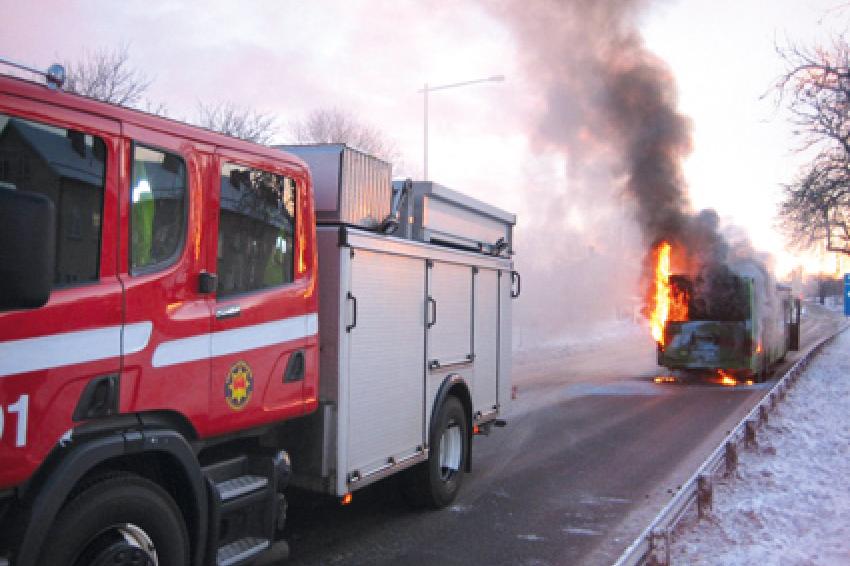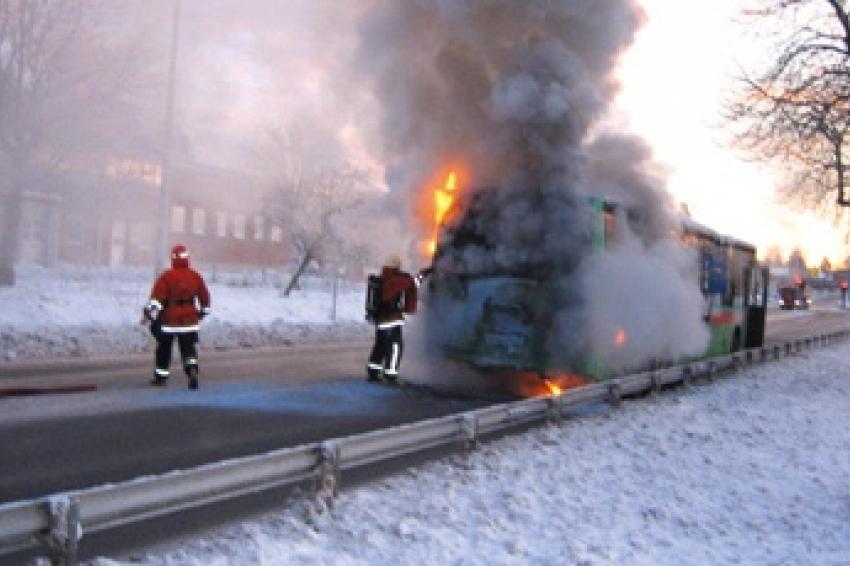Detecting and Extinguishing Fire in Public Transport Vehicles
11.02.2013 - Over the years, buses and coaches have become technical marvels in terms of comfort and safety, not least with fire protection having become an area that both manufacturers and ope...
Over the years, buses and coaches have become technical marvels in terms of comfort and safety, not least with fire protection having become an area that both manufacturers and operators have started to take more seriously.
It was the night of 8th September 2009 at the Atac bus depot on Tor Pagnotta in Rome as the depot was enveloped in flames and 24 gas-fueled buses were destroyed. Only five months earlier, another Atac depot had burnt down, destroying 30 mini-buses. On 4th November 2008, on the motorway near Garbsen in Germany, a coach carrying a group of pensioners and children caught fire. The fire spread extremely rapidly, killing 20 of the passengers, many of them still held in their seats by their seat belts. On 25th December 2011, fire at a depot in Bottrop in Germany, destroyed almost 70 buses with a value of about EUR 17 million.
The list of bus and coach fires that have resulted in major economic losses and, in the worst cases, in injuries or deaths, is long. The list of smaller bus fires with less dramatic consequences is even longer. Not surprisingly, not much is heard or seen internationally about such fires in the mass media, for understandable reasons: the operators do not want to scare the passengers.
Standard Equipment
The general reaction to bus and coach fires tends to vary, and is partly dependent on how the question is seen politically. When, for example, three buses from different manufacturers were totally destroyed by fire within one week in the summer of 2009 in Poland, it resulted in major political discussions which led to most of the large bus companies starting to install fire‑ extinguishing systems in their vehicles: a decision which puts Poland in the lead in the struggle against the rising number of bus and coach fires. The seven large European bus manufacturers, Evo‑bus (Mercedes-Benz/Setra), Irisbus/Iveco, MAN Nutzfahrzeuge (MAN/Neoplan), Scania, Solaris Bus, VDL Bus & Coach and Volvo, who together cover about 85% of the market, have for example since January 2011 begun to fit all their vehicles with fire detection systems in the engine compartment.
This simple measure gives the driver a chance to discover the fire at an early stage, with time to stop the bus or coach and get the passengers off. The right choice of materials, fitting of seat belts, requirements for manual fire extinguishers and the installation of fully automatic fire‑fighting systems in engine compartments are examples of other measures that have been applied. However, it becomes very much more complicated if the driver should then attempt to fight the fire using a manual fire extinguisher. Provided that the fire extinguisher works, and that the driver is capable of using it, it can be difficult to open the engine compartment, locate the fire and extinguish it correctly. For this reason, the existing fire detection system should be complemented by a fire‑fighting system that automatically extinguishes the fire. Nothing should be left to chance when proven technical designs are available.
This raises the question that bus and coach manufacturers, manufacturers of fire‑fighting systems, bus and coach owners and certification companies are discussing at present: What requirement should be specified for a fire‑fighting system, and how can we decide upon a suitable performance specification?
International Approval
The rising demand is attracting interest from many manufacturers that offer a multitude of fire‑fighting systems based on a wide range of designs. For the end‑user, it is often price and approvals that decide the choice of fire‑fighting system, but with what approvals can the vehicle owners, and thus also the passengers, feel safe? What test methods lie behind the approval? How does the price affect the quality and performance of fire‑fighting systems? Can we install some type of fire‑fighting system that is normally used for other applications than vehicles, without having to modify it? That these questions are not just hypothetical is shown by incidents in which buses or coaches have been destroyed even when fire‑fighting systems have been installed, and also by cases where the vehicle owners have suffered high costs due to spurious operation of the systems.
In 2004, publication by the Swedish Fire Protection Association (SBF) of its document SBF128 meant that, for the first time, there were rules directly aimed at fire‑extinguishing systems for buses. For several years, SBF128 has provided concrete help for many manufacturers and bus and coach owners in countries both within and outside Europe. The accumulated experience from this work now makes it possible to take the next step in development, and create an international standard to establish a binding performance level for manufacturers of fire‑fighting systems, bus manufacturers and bus owners. SBF, together with many interested international parties, has taken the initiative to develop an international standard. Since the 1970s, when insurance companies began to require fire protection on forest machines, Dafo Brand AB has developed designs not only for forest machines but also for contractors’ machinery, mining machinery, buses, coaches, rock‑crushing plant etc.
With some justification, Dafo Brand AB can claim to be one of the companies that were among the earliest in designing fire‑fighting systems intended specifically for use in vehicles, and thus has among the longest history of experience of this market in the world. We learned over this period that a fire‑fighting system for vehicles must be robust, able to withstand vibration, be unaffected by different climates, meet EMC requirements and, essentially, operate under all conditions, regardless of the human factor. No Fire, No Damage Choice of the right extinguishant and correct method of detection are of course also very important. Detection of a fire must be reliable, and not operate spuriously, while at the same time being sufficiently quick to operate in the event of a fire. The extinguishant must extinguish the fire as quickly as possible, effectively cool overheated parts of the engine, prevent re‑ignition, have no adverse health or environmental effects, not damage equipment in the engine compartment, and be certified.
Tests have also shown that the engine cooling fan particularly affects the distribution of the extinguishant in the engine compartment, and thus also its efficiency. Low‑density extinguishants, for example, have difficulty in suppressing fires close to the fan. Although fire‑fighting systems with the above properties are used in other industrial, private or maritime applications, it does not mean that such systems are automatically suitable for installation in vehicles. The automotive sector has extensive rules for everything that is to be used or installed, and the particular environment encountered in an engine compartment impose high requirements on the performance of fire‑fighting systems. Built In While a system must perform well in a test environment, this is not the whole story.
The system will not only be installed in existing vehicles but must also be suitable for integration in the manufacturer’s production line, which requires extensive documentation and close cooperation with their various design departments. With straight‑out‑of‑the‑box products, i.e. carefully designed system modules that can be dropped into a mass production line, the manufacturers not only save time but can also be sure of the quality of the product as all systems are installed in the same way and operate in the same manner.
The fact that the vehicle manufacturers have a deep understanding of what is required in order to protect their products, and thus also to protect their reputations, is clearly illustrated by Verbandes deutscher Omnibusunternehmer (German bus and coach operators’ association) spokesman Martin Kassler, who says, “We don’t want to have any €5 fire alarms from a DIY shop...”. This clearly shows that the German market attaches more importance to quality than to the lowest price when considering safety, where simple solutions without a proven effect would very quickly destroy economic values, the reputations of trademarks or particularly the lives of passengers.











